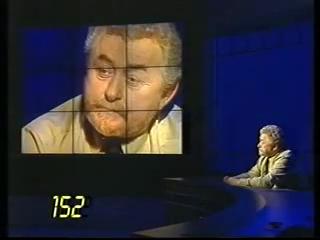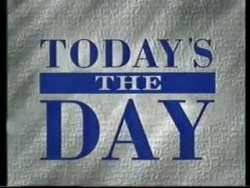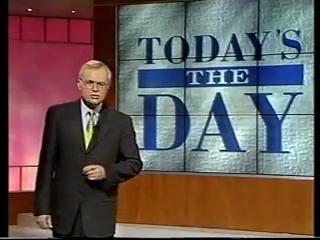Today's the Day
| Line 29: | Line 29: | ||
The second half of the show saw the winners of the first half meet the champions of the day before. This was their chance to get on the leaderboard for a chance at the Grand Final. The first round in the final was the Video Wall, where eight different clips were worth varying amount of points, the teams taking alternate picks. If they got an answer wrong it was thrown over to the other side. The second round was the One-Minute Quick-Fire round, with ten points per answer. Daily winners came back on the next programme (unless they'd won five programmes, in which case they were retired so that someone else could win), and everyone who took part won a paper that was printed on the day that they were born. | The second half of the show saw the winners of the first half meet the champions of the day before. This was their chance to get on the leaderboard for a chance at the Grand Final. The first round in the final was the Video Wall, where eight different clips were worth varying amount of points, the teams taking alternate picks. If they got an answer wrong it was thrown over to the other side. The second round was the One-Minute Quick-Fire round, with ten points per answer. Daily winners came back on the next programme (unless they'd won five programmes, in which case they were retired so that someone else could win), and everyone who took part won a paper that was printed on the day that they were born. | ||
| - | <div class="image">[[File:Todays the day contender video board.jpg]]'' | + | <div class="image">[[File:Todays the day contender video board.jpg]]''Was he in [[Mastermind]]?''</div> |
The highest scores in a daily final came back at the end of the series to compete in a knock-out competition, to determine who won the trip for two around the world. The two halves of the programme were separated by a viewers' competition, for a book or cash prize and entry into a draw at the end of the series to win a trip for two around the world. | The highest scores in a daily final came back at the end of the series to compete in a knock-out competition, to determine who won the trip for two around the world. The two halves of the programme were separated by a viewers' competition, for a book or cash prize and entry into a draw at the end of the series to win a trip for two around the world. | ||
Revision as of 04:49, 12 September 2023
Contents |
Host
Andrew Rawnsley (1993)
Martyn Lewis (1993-99)
Co-hosts
Announcer: Penny Smith
Broadcast
Mentorn Films and BBC North for BBC2, 12 July 1993 to 12 March 1999 (753 episodes)
Synopsis
Basic general knowledge/history quiz, with all the questions and answers having a reference to the day the show was being broadcast. Two teams of two (of different generations) competed each day, with the top prize for the series two round-the-world tickets. This prize was mentioned at least twice in each programme.
There were two parts of the show. The first part was when two new teams battled it out. Rounds included 'Stop the Clip', a question was asked with the clues in footage, and the quicker they buzzed in and stopped the piece of film, the more points they scored if they answered correctly. There was a TV round where teams were asked questions on classic television on that day, and the obligatory quickfire buzzer round.
The second half of the show saw the winners of the first half meet the champions of the day before. This was their chance to get on the leaderboard for a chance at the Grand Final. The first round in the final was the Video Wall, where eight different clips were worth varying amount of points, the teams taking alternate picks. If they got an answer wrong it was thrown over to the other side. The second round was the One-Minute Quick-Fire round, with ten points per answer. Daily winners came back on the next programme (unless they'd won five programmes, in which case they were retired so that someone else could win), and everyone who took part won a paper that was printed on the day that they were born.
 Was he in Mastermind?
Was he in Mastermind?The highest scores in a daily final came back at the end of the series to compete in a knock-out competition, to determine who won the trip for two around the world. The two halves of the programme were separated by a viewers' competition, for a book or cash prize and entry into a draw at the end of the series to win a trip for two around the world.
This show was originally commissioned as a six episode pilot run for two weeks during the summer of 1993 in the 5pm teatime slot and was hosted by Andrew Rawnsley, a political pundit who writes for The Guardian. It was well received and was given an extended run in November 1993 right up until Christmas, but Andrew was replaced by BBC newsreader Martyn Lewis whose gentle-natured style of hosting became very popular. In January 1994, Today's the Day swapped timeslots with Catchword, which meant that Today's the Day now aired at 4pm. (Why not 4.30? Countdown was unstoppable.)
However in April 1997, the revival of Blockbusters shoved Today's the Day to a later slot of 5.30pm, so it now went head to head with a teatime repeat of Neighbours on BBC1. The competition leaderboard was abolished after the final in April 1998. A new format was tried the following year, a member of a former champion team paired with a celebrity, but the viewers had had their fill of nostalgia questions with a tenuous link to this date in history. Today's the Day slipped gracefully off our screens in March 1999.
This was a quiz-by-numbers, but it was pleasant and quite cosy and did what it did quite well. Channel 4 attempted to capture the same nostalgia zeitgeist with the markedly less successful Backdate.
Trivia
There was also a spin-off on BBC Radio 2, where Martyn Lewis played news and entertainment clips from the archives, and talked to some of the people featured.
Merchandise
Book:
by Martyn Lewis
Web links
See also
Videos
The 1997 Christmas Special.



